Fan marches are rooted in cultural expression but can challenge city authorities’ control over public safety. Law enforcement develops protocols focusing on crowd management, communication, and technology like surveillance to maintain order while respecting fans’ rights. Balancing safety with freedom involves ethical considerations and community engagement. These protocols evolve with social changes and innovations like real-time data and predictive tools. To understand how cities navigate this complex dance, keep exploring the strategies and challenges involved.
Key Takeaways
- City policing protocols for fan marches emphasize legal compliance, permit systems, and balancing cultural expression with public safety.
- Crowd management strategies include proactive planning, understanding crowd psychology, and implementing control measures like barriers and rerouting.
- Community engagement and transparent communication with fans and residents help build trust and prevent conflicts during marches.
- Advanced technologies such as surveillance drones and facial recognition enhance real-time monitoring and response capabilities.
- Future protocols incorporate predictive analytics and virtual reality training to improve officer preparedness and maintain public trust.
Historical Context of Fan Marches and Urban Policing

Understanding the roots of fan marches and urban policing reveals a long history of how authorities have responded to large gatherings. Historically, sports rivalry fuels these marches as fans see them as a form of cultural expression, celebrating their teams and community identity. Such events often challenge the authority’s control, leading to tensions over public order. In many cases, police have viewed these gatherings as potential threats to safety or social stability, prompting increased surveillance and intervention. Over time, authorities have developed protocols to manage these marches, balancing respect for cultural expression with the need for security. Recognizing this history helps you understand why modern policing strategies often stem from a complex legacy of managing passionate fan displays rooted in sports rivalry. Additionally, public safety measures have evolved as part of these protocols to adapt to changing social dynamics.
Legal Frameworks Governing Public Gatherings
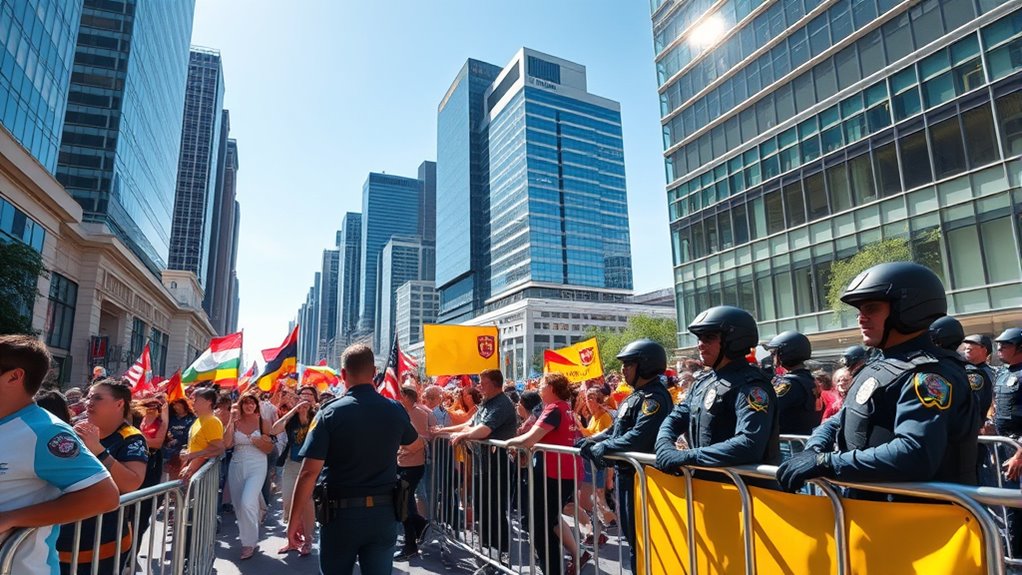
Legal frameworks play a essential role in regulating public gatherings, establishing the rights and responsibilities of both organizers and authorities. These laws often require organizers to obtain protest permits to ensure safety and order but also provide legal exemptions for specific types of gatherings, like spontaneous demonstrations or religious events. Understanding these regulations helps you navigate what’s legally permitted and how authorities can enforce rules. Permit systems give authorities a way to plan security measures, while exemptions recognize circumstances where formal approval isn’t necessary. Compliance with these frameworks ensures your gathering remains lawful, reducing the risk of clashes or legal consequences. Familiarity with local laws and procedures allows you to organize or participate in public events confidently and responsibly. Additionally, knowing about patched skincare products can help ensure personal safety if such items are involved in the event environment.
Strategies for Crowd Management and Control
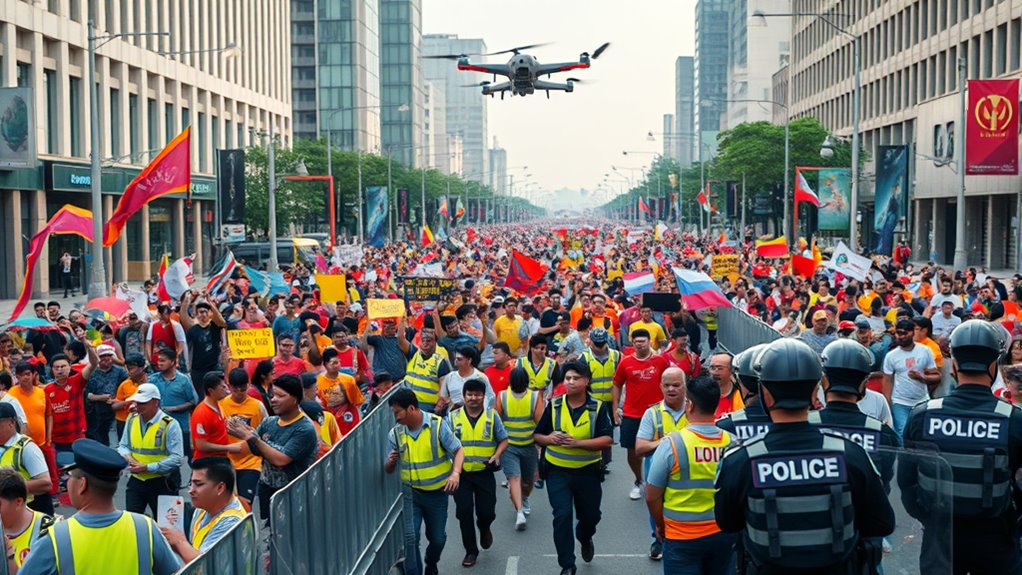
Effective crowd management begins with strategic planning that anticipates potential issues and assigns clear roles to security personnel. Understanding crowd psychology helps you predict behaviors, enabling proactive measures. Managing media coverage is vital, as it shapes public perception and can escalate tensions if mishandled. To deepen your approach, consider this table:
| Observation | Response | Outcome |
|---|---|---|
| Rising agitation | Deploy additional security | Calm is restored |
| Negative media reports | Communicate transparently | Maintains public trust |
| Crowd density issues | Use barriers and rerouting | Prevents stampedes |
This strategy ensures you’re prepared, minimizes risks, and maintains order during fan marches. Incorporating self watering plant pots concepts like proactive water management can serve as a metaphor for maintaining optimal conditions and preventing crises in crowd control scenarios.
Role of Community Engagement and Communication

Community engagement and clear communication are essential tools for ensuring crowd safety and fostering goodwill during fan marches. When you actively involve community members and listen to their concerns, you build trust that can prevent misunderstandings or tensions from escalating. Open dialogue helps you address potential conflicts early, making conflict resolution smoother and more effective. By sharing information transparently about march routes, safety measures, and police intentions, you promote cooperation rather than suspicion. This approach encourages fans and residents to feel respected and heard, reducing the likelihood of confrontations. Incorporating regular breaks and time management techniques can also help maintain a peaceful atmosphere by reducing stress and fatigue among participants. Ultimately, strong community trust and effective communication serve as the foundation for a peaceful, organized event, making your efforts more successful and positive for everyone involved.
Use of Technology in Monitoring and Safety Measures
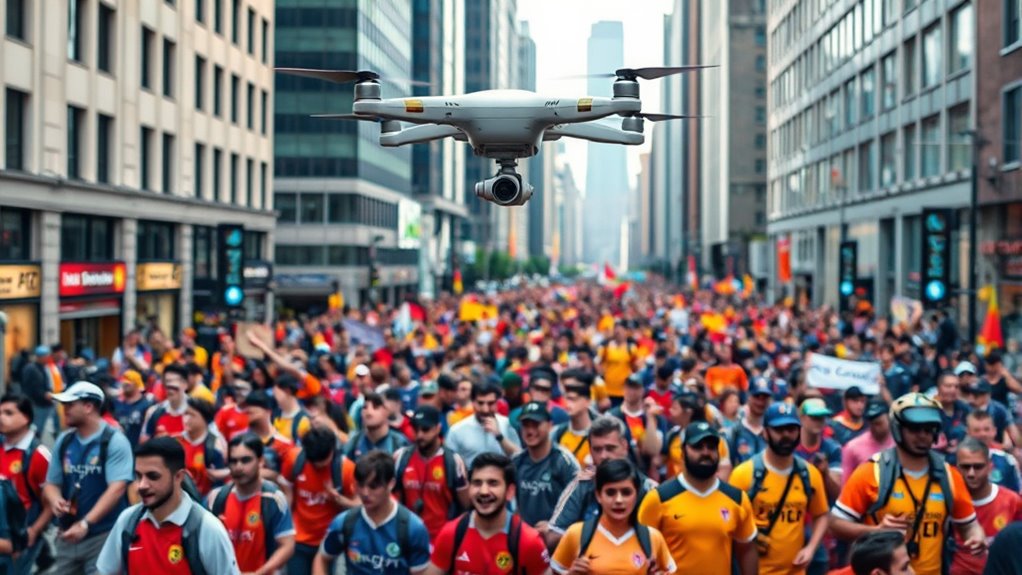
Technology plays a crucial role in enhancing crowd monitoring and safety during fan marches, allowing you to respond quickly to emerging issues. Surveillance drones give you real-time aerial views, helping you track large crowds and identify potential threats from above. Facial recognition technology enables you to quickly identify individuals of concern, such as known troublemakers or missing persons. Here are key benefits: 1. Improved situational awareness through drone footage. 2. Faster identification of individuals using facial recognition. 3. Enhanced decision-making with real-time data. Understanding informal language today can also help law enforcement communicate more effectively with diverse crowds.
Challenges Faced by Law Enforcement Agencies
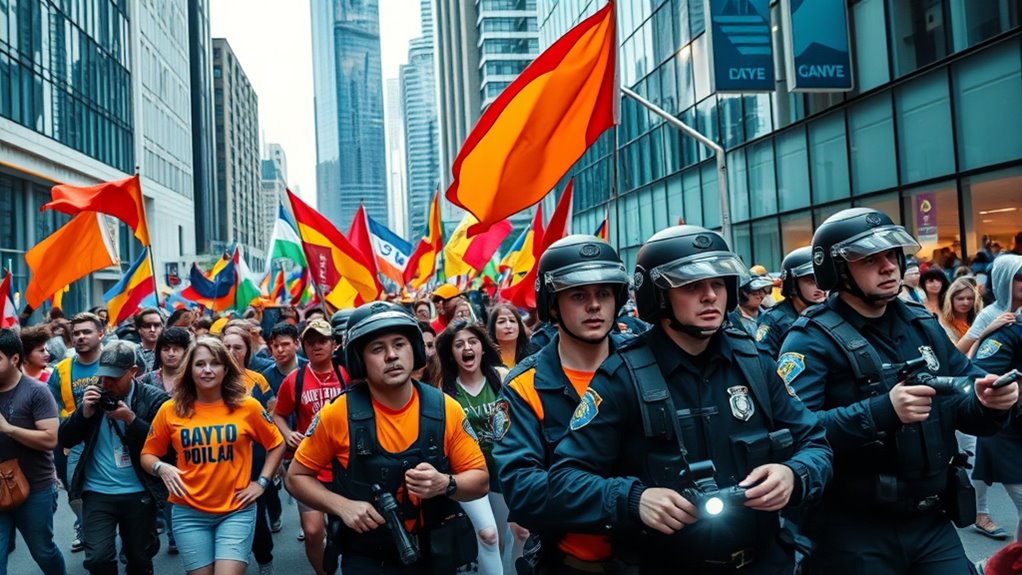
Law enforcement agencies face significant challenges during fan marches, especially when balancing crowd control with respecting individual rights. You need to manage passionate fans whose loyalty runs deep, often driven by march symbolism that fuels unity and identity. These events can quickly escalate if emotions run high or if marchers express dissent. Maintaining safety while avoiding unnecessary confrontations demands careful planning and flexibility. You must recognize that fan loyalty influences behavior, which can lead to unpredictable situations. Additionally, the symbolism behind marches can be misinterpreted, complicating police responses. The table below highlights common challenges you encounter:
| Challenge | Impact | Strategy |
|---|---|---|
| Managing emotions | Potential for escalation | De-escalation training |
| Protecting march symbolism | Respecting cultural significance | Clear communication |
| Crowd size | Difficult crowd control | Adequate staffing |
| Fan loyalty influence | Unpredictable behavior | Community engagement |
| Balancing rights | Risk of rights infringement | Clear protocols |
Furthermore, understanding crowd behavior can help tailor responses to maintain order effectively.
Case Studies of Notable Fan Marches and Responses
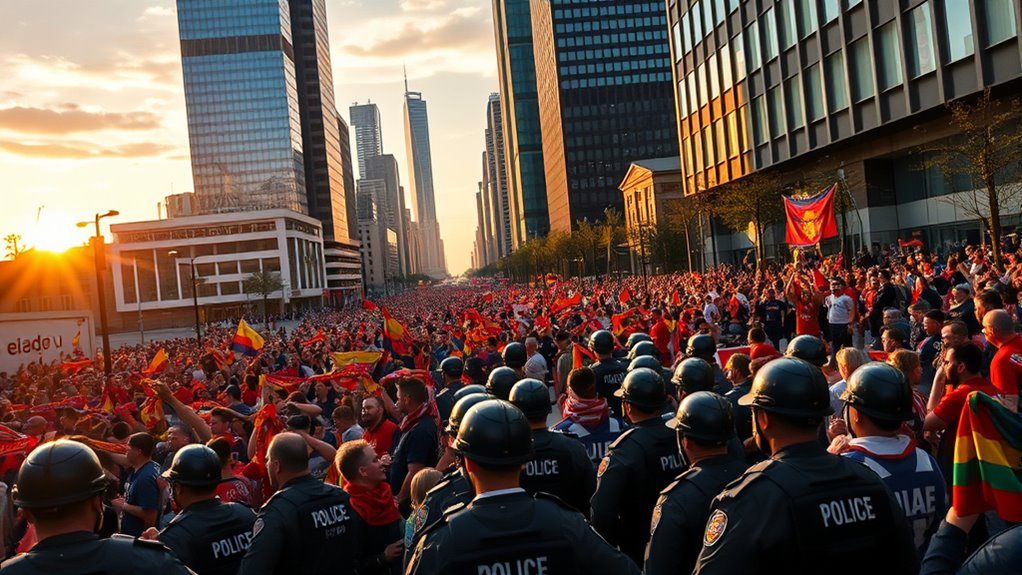
Examining notable fan marches reveals how law enforcement agencies adapt their responses to complex scenarios. Vigilant oversight and understanding crowd psychology are essential in these efforts. Successful responses often follow a strategic approach, including:
- Monitoring crowd behavior closely to anticipate escalation
- Deploying officers in positions that maximize visibility and control
- Engaging with organizers to coordinate safe march routes and timings
- Implementing personal empowerment techniques to manage stress and react effectively under pressure
Balancing Rights and Safety: Ethical Considerations

Balancing the right to peaceful protest with the need to guarantee public safety presents a complex ethical challenge for law enforcement and event organizers alike. Fan behavior can quickly shift from passionate support to disruptive actions, creating ethical dilemmas about intervention. You must decide when to prioritize safety without infringing on fans’ rights to express their views. It’s a delicate line—too strict, and you risk suppressing free speech; too lenient, and safety may be compromised. Your goal is to uphold ethical standards by managing fan conduct responsibly, ensuring safety while respecting individual rights. This equilibrium requires constant assessment of fan behavior, clear communication, and a commitment to fairness. Incorporating protective styling benefits into crowd management strategies can help minimize risks associated with fan gatherings. Steering through these dilemmas is vital to maintaining legitimacy and public trust during fan marches.
Future Trends in Policing Fan Marches
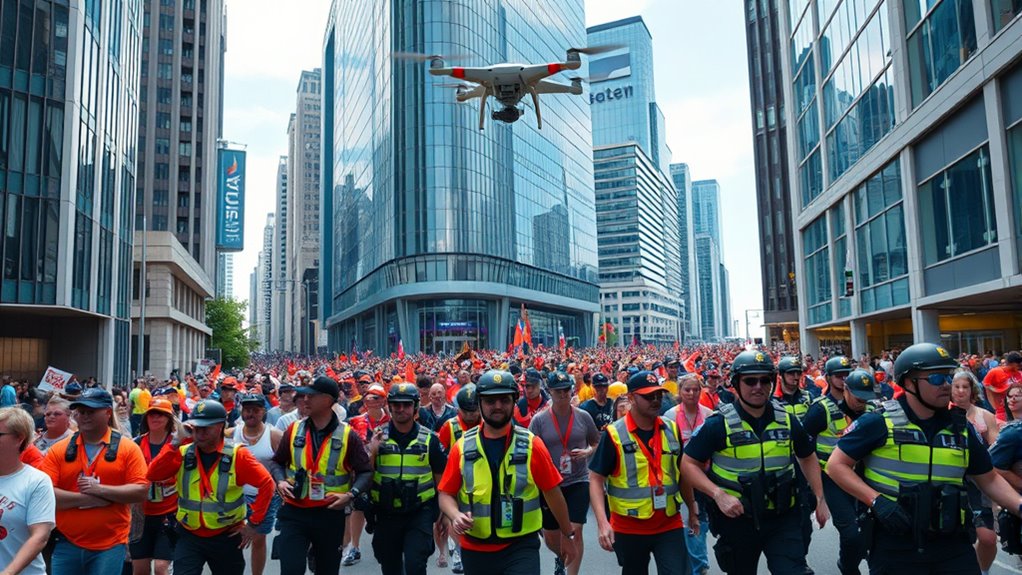
As technology continues to evolve, future policing of fan marches is likely to incorporate advanced tools such as real-time surveillance, predictive analytics, and social media monitoring. With predictive analytics, you can anticipate crowd behavior, enabling proactive measures instead of reactive ones. Virtual reality may also play a role by training officers in simulated crowd scenarios, improving response strategies. Here are some key trends to watch for:
Future policing will leverage real-time data, predictive analytics, and VR training to enhance safety and respect rights.
- Enhanced prediction of march dynamics and potential disturbances
- Real-time data analysis for swift decision-making
- Virtual reality training to prepare officers for complex situations
- Retail hours and scheduling innovations that could influence crowd control planning in public spaces
These innovations will help balance safety and rights more effectively, allowing you to better manage large gatherings while respecting individual freedoms. The integration of these technologies aims to create smarter, safer policing practices in the future.
Frequently Asked Questions
How Do Police Decide When to Allow or Restrict Fan Marches?
When deciding to allow or restrict fan marches, police prioritize public safety and legal considerations. You’ll find they assess the potential for violence, crowd control challenges, and the march’s timing or route. If risks are too high or legal permits aren’t obtained, restrictions may be enforced. Their goal is to balance respecting free expression while ensuring the safety of all participants and the general public.
What Training Do Officers Receive for Managing Large Crowds at Fan Marches?
You might wonder about the training officers get for managing large crowds. They undergo specialized officer training focused on crowd control techniques, communication skills, and conflict de-escalation. This training prepares you to handle high-pressure situations calmly and effectively. It emphasizes safety for both the crowd and officers, teaching you how to recognize potential issues early and respond appropriately. Such preparation guarantees that you can manage fan marches professionally and safely.
How Do Cultural Differences Influence Policing Approaches to Fan Marches Worldwide?
You might be surprised to learn that 65% of police forces worldwide adapt their crowd control strategies based on cultural sensitivities. These differences influence how officers approach fan marches, emphasizing community engagement to foster trust and prevent conflicts. Understanding local customs helps officers de-escalate tensions better, ensuring safety while respecting diverse traditions. By recognizing cultural nuances, police can create more effective, respectful policing approaches that promote positive interactions during large gatherings.
What Are the Financial Costs Associated With Policing Fan Marches?
You need to take into account the financial costs associated with policing fan marches, which include personnel wages, equipment, and logistics. These costs impact your city’s budget allocation, often requiring reallocating funds from other services. Additionally, the economic impact extends beyond policing expenses, affecting local businesses and tourism. Managing these costs effectively ensures safety without overburdening your city’s resources, balancing public safety with economic stability during such events.
How Do Fan Organizations Collaborate With Law Enforcement During Marches?
Imagine a delicate dance where each step must be perfectly timed. You, as part of a fan group, collaborate with law enforcement through careful march planning strategies and fan group coordination. You share insights, set boundaries, and communicate openly to guarantee safety and order. This partnership transforms chaos into harmony, allowing the march to proceed smoothly. Your joint efforts create a symphony of cooperation, turning a potentially tumultuous event into a memorable, positive experience.
Conclusion
Ultimately, mastering fan marches feels like trying to tame a wild hurricane—chaotic, unpredictable, and powerful. As you navigate the delicate dance between rights and safety, remember that every decision can tip the scales. With evolving technology and strategies, law enforcement is racing against time to keep the storm of passion in check. So, stay vigilant, because in this game, one misstep could release a tidal wave of chaos!









